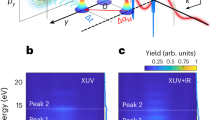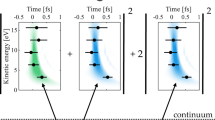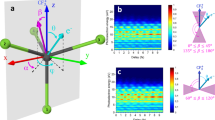Abstract
Photoemission of an electron is commonly treated as a one-particle phenomenon. With attosecond streaking spectroscopy we observe the breakdown of this single active-electron approximation by recording up to six attoseconds retardation of the dislodged photoelectron due to electronic correlations. We recorded the photon-energy-dependent emission timing of electrons, released from the helium ground state by an extreme-ultraviolet photon, either leaving the ion in its ground state or exciting it into a shake-up state. We identify an optical field-driven d.c. Stark shift of charge-asymmetric ionic states formed after the entangled photoemission as a key contribution to the observed correlation time shift. These findings enable a complete wavepacket reconstruction and are universal for all polarized initial and final states. Sub-attosecond agreement with quantum mechanical ab initio modelling allows us to determine the absolute zero of time in the photoelectric effect to a precision better than 1/25th of the atomic unit of time.
This is a preview of subscription content, access via your institution
Access options
Subscribe to this journal
Receive 12 print issues and online access
$209.00 per year
only $17.42 per issue
Buy this article
- Purchase on Springer Link
- Instant access to full article PDF
Prices may be subject to local taxes which are calculated during checkout




Similar content being viewed by others
References
Einstein, A. Über einen die Erzeugung und Verwandlung des Lichtes betreffenden heuristischen Gesichtspunkt. Ann. Phys. 322, 132–148 (1905).
Schultze, M. et al. Delay in photoemission. Science 328, 1658–1662 (2010).
Klünder, K. et al. Probing single-photon ionization on the attosecond time scale. Phys. Rev. Lett. 106, 143002 (2011).
Eckle, P. et al. Attosecond ionization and tunneling delay time measurements in helium. Science 322, 1525–1529 (2008).
Sabbar, M. et al. Resonance effects in photoemission time delays. Phys. Rev. Lett. 115, 133001 (2015).
Palatchi, C. et al. Atomic delay in helium, neon, argon and krypton. J. Phys. B 47, 245003 (2014).
Wigner, E. P. Lower limit for the energy derivative of the scattering phase shift. Phys. Rev. 98, 145–147 (1955).
Eisenbud, L. The Formal Properties of Nuclear Collisions (Princeton Univ., 1948).
Smith, F. T. Lifetime matrix in collision theory. Phys. Rev. 118, 349–356 (1960).
Nussenzveig, H. M. Time delay in quantum scattering. Phys. Rev. D 6, 1534–1542 (1972).
de Carvalho, C. A. A. & Nussenzveig, H. M. Time delay. Phys. Rep. 364, 83–174 (2002).
Sassoli de Bianchi, M. Time-delay of classical and quantum scattering processes: a conceptual overview and a general definition. Centr. Eur. J. Phys. 10, 282–319 (2012).
Tew, D. P., Klopper, W. & Helgaker, T. Electron correlation: the many-body problem at the heart of chemistry. J. Comput. Chem. 28, 1307–1320 (2007).
Fulde, P. Electron Correlations in Molecules and Solids (Springer Science & Business Media, 2012).
Datta, S. Electronic Transport in Mesoscopic Systems (Cambridge Univ. Press, 1997).
Auerbach, A. Interacting Electrons and Quantum Magnetism (Springer, 1994).
Hubbard, J. Electron correlations in narrow energy bands. Proc. R. Soc. Lond. A 276, 238–257 (1963).
Pazourek, R., Feist, J., Nagele, S. & Burgdörfer, J. Attosecond streaking of correlated two-electron transitions in helium. Phys. Rev. Lett. 108, 163001 (2012).
Dahlström, J. M., L’Huillier, A. & Maquet, A. Introduction to attosecond delays in photoionization. J. Phys. B 45, 183001 (2012).
Nagele, S., Pazourek, R., Feist, J. & Burgdörfer, J. Time shifts in photoemission from a fully correlated two-electron model system. Phys. Rev. A 85, 033401 (2012).
Kheifets, A. S. Time delay in valence-shell photoionization of noble-gas atoms. Phys. Rev. A 87, 063404 (2013).
Zhang, C.-H. & Thumm, U. Streaking and Wigner time delays in photoemission from atoms and surfaces. Phys. Rev. A 84, 033401 (2011).
Sukiasyan, S., Ishikawa, K. L. & Ivanov, M. Attosecond cascades and time delays in one-electron photoionization. Phys. Rev. A 86, 033423 (2012).
Moore, L. R., Lysaght, M. A., Parker, J. S., van der Hart, H. W. & Taylor, K. T. Time delay between photoemission from the 2p and 2s subshells of neon. Phys. Rev. A 84, 061404 (2011).
Baggesen, J. C. & Madsen, L. Atomic and molecular phases through attosecond streaking. Phys. Rev. A 83, 021403(R) (2011).
Kheifets, A. S., Saha, S., Deshmukh, P. C., Keating, D. A. & Manson, S. T. Dipole phase and photoelectron group delay in inner-shell photoionization. Phys. Rev. A 92, 063422 (2015).
Zhang, C.-H. & Thumm, U. Electron-ion interaction effects in attosecond time-resolved photoelectron spectra. Phys. Rev. A 82, 043405 (2010).
Baggesen, J. C. & Madsen, L. B. Polarization effects in attosecond photoelectron spectroscopy. Phys. Rev. Lett. 104, 043602 (2010).
Nagele, S. et al. Time-resolved photoemission by attosecond streaking: extraction of time information. J. Phys. B 44, 081001 (2011).
Heimann, P. A. et al. Helium and neon photoelectron satellites at threshold. Phys. Rev. A 34, 3782–3791 (1986).
Itatani, J. et al. Attosecond streak camera. Phys. Rev. Lett. 88, 173903 (2002).
Yakovlev, V. S., Gagnon, J., Karpowicz, N. & Krausz, F. Attosecond streaking enables the measurement of quantum phase. Phys. Rev. Lett. 105, 073001 (2010).
Feist, J. et al. Nonsequential two-photon double ionization of helium. Phys. Rev. A 77, 043420 (2008).
Schneider, B. I. et al. Quantum Dynamic Imaging 149–208 (Springer Science & Business Media, 2011).
Ivanov, M. & Smirnova, O. How accurate is the attosecond streak camera? Phys. Rev. Lett. 107, 213605 (2011).
Palacios, A., McCurdy, C. W. & Rescigno, T. N. Extracting amplitudes for single and double ionization from a time-dependent wave packet. Phys. Rev. A 76, 043420 (2007).
Woodruff, P. R. & Samson, J. A. R. Measurements of partial cross sections and autoionization in the photoionization of helium to He+ (N = 2). Phys. Rev. A 25, 848–856 (1982).
Trebino, R. et al. Measuring ultrashort laser pulses in the time-frequency domain using frequency-resolved optical gating. Rev. Sci. 68, 3277–3295 (1997).
Vampa, G. & Villeneuve, D. M. High-harmonic generation: to the extreme. Nat. Phys. 11, 529–530 (2015).
Luu, T. T. et al. Extreme ultraviolet high-harmonic spectroscopy of solids. Nature 521, 498–502 (2015).
Ghimire, S. et al. Strong-field and attosecond physics in solids. J. Phys. B 47, 204030 (2014).
Schultze, M. et al. Attosecond band-gap dynamics in silicon. Science 346, 1348–1352 (2014).
Ramachandran, P. & Varoquaux, G. Mayavi: 3D visualization of scientific data. Comput. Sci. Eng. 13, 40–51 (2011).
Schweinberger, W. et al. Waveform-controlled near-single-cycle milli-joule laser pulses generate sub-10 nm extreme ultraviolet continua. Opt. Lett. 37, 3573–3575 (2012).
Corkum, P. B. Plasma perspective on strong-field multiphoton ionization. Phys. Rev. Lett. 71, 1994–1997 (1993).
Schafer, K. & Kulander, K. High harmonic generation from ultrafast pump lasers. Phys. Rev. Lett. 78, 638–641 (1997).
Hofstetter, M. et al. Lanthanum–molybdenum multilayer mirrors for attosecond pulses between 80 and 130 eV. New J. Phys. 13, 063038 (2011).
Mairesse, Y. et al. Attosecond synchronization of high-harmonic soft x-rays. Science 302, 1540–1543 (2003).
Fiess, M. et al. Versatile apparatus for attosecond metrology and spectroscopy. Rev. Sci. 81, 093103 (2010).
Becker, U. & Shirley, D. A. VUV and Soft X-ray Photoionization (Springer Science & Business Media, 2012).
Acknowledgements
We acknowledge insightful comments and generous infrastructural support from F. Krausz. This work was supported by the Max Planck Society, the Deutsche Forschungsgemeinschaft Cluster of Excellence: Munich Centre for Advanced Photonics (http://www.munich-photonics.de), the Austrian Science Foundation project NEXTLITE (F049 and P23359-N16) and LASERLAB-EUROPE (grant agreement no. 654148, European Union’s Horizon 2020 research and innovation programme). J.F. acknowledges funding by the European Research Council (ERC-2011-AdG Proposal 290981). R.K. acknowledges a Consolidator Grant from the European Research Council (ERC-2014-CoG AEDMOS). M.S. was supported by a Marie Curie International Outgoing Fellowship (FP7-PEOPLE-2011-IOF). The computational results presented have been achieved (in part) using the Vienna Scientific Cluster (VSC).
Author information
Authors and Affiliations
Contributions
Experimental studies and analysis of experimental and theoretical signatures were carried out by M.O., F.S., V.S., A.S., T.L. and M.S. Theory and modelling were performed by R.P., supported by S.N. and J.F., and supervised by J.B. Customized XUV optics were provided by A.G. The manuscript was written by M.O., F.S. and M.S. All authors discussed the results and commented on the paper.
Corresponding authors
Ethics declarations
Competing interests
The authors declare no competing financial interests.
Supplementary information
Supplementary information
Supplementary information (PDF 2198 kb)
Rights and permissions
About this article
Cite this article
Ossiander, M., Siegrist, F., Shirvanyan, V. et al. Attosecond correlation dynamics. Nature Phys 13, 280–285 (2017). https://doi.org/10.1038/nphys3941
Received:
Accepted:
Published:
Issue Date:
DOI: https://doi.org/10.1038/nphys3941
This article is cited by
-
Raman time-delay in attosecond transient absorption of strong-field created krypton vacancy
Nature Communications (2024)
-
Nonlinear-optical quantum control of free-electron matter waves
Nature Physics (2023)
-
Reply to: On yoctosecond science
Nature (2022)
-
Atomic partial wave meter by attosecond coincidence metrology
Nature Communications (2022)
-
Attosecond dynamics of multi-channel single photon ionization
Nature Communications (2022)



